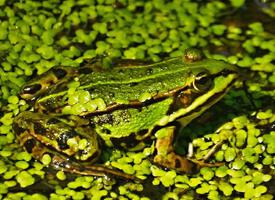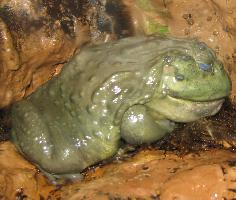
Poids et mesures
| Longueur | 40 cm |
|---|---|
| Poids | 4 kg |
Données biologiques
| Durée de vie | 15 r |
|---|
Statut de conservation
| Menacé |
Description de l'animal
The Goliath frog, scientifically known as Conraua goliath, is a remarkable and fascinating creature that stands out as the largest living frog on Earth. Native to the dense rainforests and fast-flowing rivers and waterfalls of Cameroon and Equatorial Guinea in West Africa, this amphibian has captivated the interest of scientists, conservationists, and wildlife enthusiasts around the globe.Characterized by its immense size, an adult Goliath frog can reach lengths of up to 32 centimeters (about 13 inches) from snout to vent, and it can weigh as much as 3.3 kilograms (over 7 pounds). Such dimensions make it a giant among frogs, dwarfing other species in comparison. The skin of the Goliath frog is smooth and slippery, predominantly green in color, with shades ranging from olive to bright green, which provides excellent camouflage in its lush, verdant habitat.
Despite their colossal size, Goliath frogs have a life cycle that begins in a remarkably delicate state. Their eggs are laid and fertilized in water, where they hatch into tadpoles. These tadpoles undergo a metamorphosis, transitioning from their larval aquatic stage to become fully formed frogs. Interestingly, the diet of Goliath frogs plays a significant role in their growth. While the tadpoles are herbivorous, feeding primarily on a single species of plant found in their habitat, adult Goliath frogs are carnivorous and have been known to consume a wide variety of prey, including insects, small mammals, and other amphibians.
Goliath frogs possess powerful hind legs, which are not only a distinguishing physical characteristic but also serve a critical function. These muscular limbs enable the frogs to make extraordinary leaps and also aid in swimming against strong currents in their riverine environments. However, despite their strength and agility, Goliath frogs lead a predominantly sedentary lifestyle, often remaining motionless for extended periods, which aids in ambushing prey.
One of the most intriguing aspects of the Goliath frog's behavior is its nesting habits. Unlike many other frog species that lay their eggs in water, the Goliath frog constructs a sort of nest. The male frog clears an area on the riverbed by moving rocks and debris, creating a safer environment for the eggs. This unique behavior underscores the complexity of these creatures and their adaptation to their specific ecological niche.
Unfortunately, the Goliath frog faces significant threats from habitat destruction, pollution, and overharvesting. Their large size and rarity make them a target for hunters, who capture them for food and the pet trade. As a result, the Goliath frog is classified as Endangered by the International Union for Conservation of Nature (IUCN), highlighting the urgent need for conservation efforts to ensure the survival of this magnificent species.
In summary, the Goliath frog is a fascinating and unique amphibian that embodies the incredible diversity of life on our planet. Its extraordinary size, intriguing lifecycle, and complex behaviors make it a subject of great interest and also a symbol of the delicate balance within ecosystems. As efforts continue to protect and preserve the Goliath frog, it serves as a reminder of the importance of biodiversity and the interconnectedness of all living things.
Animaux similaires
Nouvelles photos d'animaux
Top 10 des animaux
- Dolphin gull (Leucophaeus scoresbii)
- Japanese macaque (Macaca fuscata)
- Stone loach (Barbatula barbatula)
- Greek tortoise (Testudo graeca)
- Russian tortoise (Testudo horsfieldii)
- Galápagos tortoise (Geochelone nigra complex)
- Diana monkey (Cercopithecus diana)
- Moustached guenon (Cercopithecus cephus)
- Common flying dragon (Draco volans)
- Galápagos penguin (Spheniscus mendiculus)


